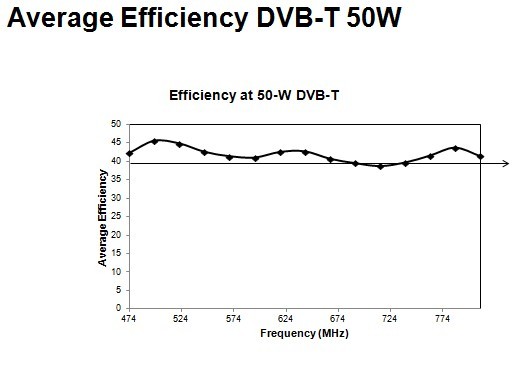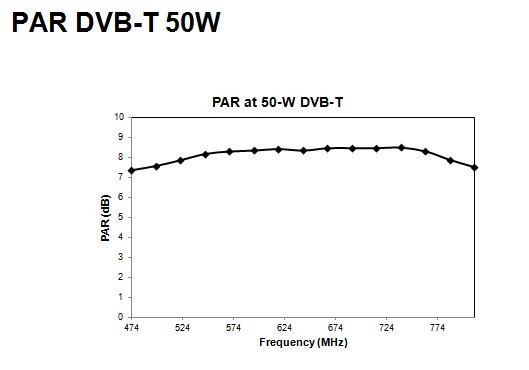NXP Develops Industry?s First Full-Band UHF Doherty Architecture
October 30, 2012
High efficiency and high bandwidth combined in new solution for digital transmitters
Eindhoven, Netherlands, October 30, 2012 ? Building on its leadership position in the digital broadcast market, NXP Semiconductors N.V. (NASDAQ: NXPI) today announced that it has developed the industry?s first ultra wideband solution for Doherty architectures. This patent-pending solution will uniquely enable manufacturers of digital transmitters to enjoy the high-efficiency gains that Doherty power amplifiers confer with greatly expanded bandwidth.
The pressure to deliver richer content is driving manufacturers of broadcast equipment to demand higher efficiency transmitters that utilize the maximum power available and are as cost-effective as possible. Doherty topologies offer 45-50% efficiency, representing at least 15% improvement over traditional UHF technologies that only reach 30% efficiency, and are proving to be increasingly popular. However, the principal challenge up until now has been how best to apply the narrow-band high efficiency benefits of Doherty amplifiers to a market that requires a solution that covers some 400 MHz of bandwidth.
Building on its expertise in Doherty base stations, NXP has developed an innovative solution to this challenge, creating a new Doherty architecture capable of operating over an ultra wideband spectrum. In addition, it has achieved this innovation without an increase in the bill of materials. This high-efficiency solution uses NXP?s leading edge 50 V LDMOS technology and supports the full UHF band without any compromise in power and cost. NXP is showing the technology at European Microwave Week 2012 in Amsterdam, and expects to be able to offer the solution to customers within the next 2-3 months. An overview of the demo is available here: http://www.youtube.com/watch?v=e18utnPNNG8
NXP has a very strong leadership position in Doherty architectures ? the company has an extensive Doherty IP portfolio and employs the world?s leading expert in this area. NXP helps its customers by providing flexible Doherty reference designs to fit specific customer timing and performance criteria (such as efficiency and bandwidth) in the UHF band.
?We believe that the new ultra wideband variant of Doherty will have a major impact on the digital broadcast market,? said Mark Murphy, director of marketing, RF power and base stations, NXP Semiconductors. ?Today\'s high-performance TV transmitters constitute serious investments, and so our customers need to implement higher efficiency solutions without incurring extra costs, and without delaying time to market. For this challenge to be met, the market needs suppliers who not only provide leading-edge products in areas such as Doherty power amplifiers, but can also offer expert application support to match. This is exactly where NXP fits in.?
- - - Updated - - -


At the moment your indications are completely FALSE! And I'm sure for that! The board showed by the youtube link is a narrowband differential doherty UHF demo, nothing more. Actually there are only two broadcast companies which have developed a REAL doherty solution for the UHF band, the first was SSBT, Screen Service Broadcasting Technology (they presented the first 700W doherty transmitter last year during NAB, april 2012). Then Rohde & Schwarz presents their solutions during IBC 2012 (september). Both solutions are narrow band, but they said that the frequencies can be easily changed by local technicians, if needed. After one month NXP said that they have a solution to implement a wideband doherty and they use youtube to deliver this idea to affect the LDMOS market (the same they did in the past when they present the first fake version of BLF888, a device that will be replaced quickly after 8 monts because it has big internal bugs), but at the moment they have... NOTHING to be presentable! Today they have only an "half band" doherty solution that works not so bad, but for a wideband architecture they still thinking to a new LDMOS the BLF888-D (which is completely different from the main versions A and B). This device is composed by two different dies inside one package, one for the main amplifier, and the second one ONLY for the peak amplifier. But this device is not available up to now, it will be abailable in the future (I said...perhaps). The curves you have reported are only some pictures extracted from simulations, not more.
What is with this guys anyway? Start to advertise their products on youtube? Actually I knew they are cheap. About 5 years ago when I visited an office they have in Cumberland, Rhode Island (also developing Doherty solutions), I can't believed when I saw they sub-rented the office from a dental office ! Because, they said was cheaper. Probably the founder Gerard Philips is spinning in its grave.
At the moment only a BLF884 wideband doherty demo has been presented by NXP. The wideband idea seems related to the doherty combining close to the drain of transistors before output impedance matching. Please don't ask me more... it seems patent pending, sorry! Anyway it didn't works by using a standard DPD without improving agorithm. Furthermore, on the working channels, the efficiency obtained was not so good as they said (MER < 33dB after DPD), at 70Wrms only one channel has matched linearity specifications, other channels were completely out of specs. So, it seems if you want to match efficiency you couldn't match linearity and viceversa. Good idea for wideband solution but very bad idea the patent
Yes, I have BLF888D on my desk already, which is under mass production now. The picture I posted is real, not a simulation. Here is a link, you can find the real test data:
http://v.youku.com/v_show/id_XNTY3Mzg3NTI4.html
Yes, I have BLF888D on my desk already, which is under mass production now. The picture I posted is real, not a simulation. Here is a link, you can find the real test data:
http://v.youku.com/v_show/id_XNTY3Mzg3NTI4.html
May be the prelimilary demo is not optimized well, but now or later you will find a better one. Research is not stoped.
Ah, you're saying you have BLF888D demo on your desk... Maybe... You're lucky! Nobody have another demo like yours at the moment. The link you are referring for is referred to a narrowband application, not wideband, it is a fake! I'm sure BLF888D can really support a wideband doherty in the future, but please stop any further comment before it will be relally done! If a product is not optimized the production is ONLY LIMITED, mass production will be set-up ONLY when ALL regression tests will give them (NXP) the best results in terms of efficiency vs ruggedness with respect to S22 mismatch.
